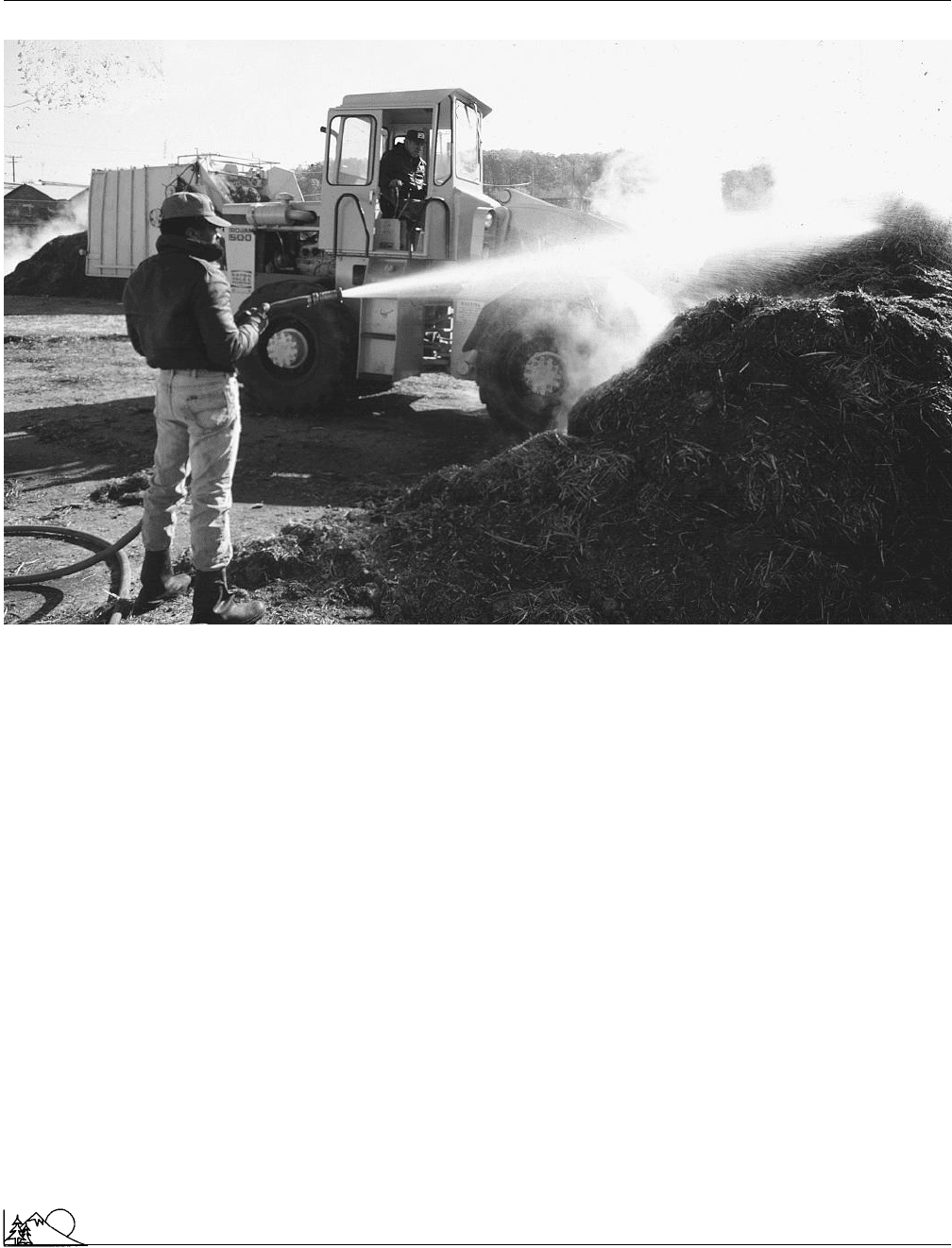Environmental Encyclopedia
Подождите немного. Документ загружается.


Environmental Encyclopedia 3
Composting
are less able to take advantage of subtle differences in an
environment. Situations in which one species of plant takes
over an area, causing the extinction of competitors, are well
known.
One mechanism that plants use in this battle with
each other is the release of toxic
chemicals
, known as allelo-
chemicals. These chemicals suppress the growth of plants
in other—and, sometimes, the same—species. Naturally oc-
curring antibiotics are examples of such allelochemicals.
[David E. Newton]
R
ESOURCES
B
OOKS
Moran, J. M., M. D. Morgan, and J. H. Wiersma. Environmental Science.
Dubuque, IA: William C. Brown, 1993.
Competitive exclusion
Competitive exclusion is the interaction between two or
more
species
that compete for a resource that is in limited
supply. It is n ecological principle involving competitors with
similar requirements for
habitat
or resources; they utilize a
similar
niche
. The result of the
competition
is that one or
more of the species is ultimately eliminated by the species
that is most efficient at utilizing the limiting resource, a
driving force of
evolution
. The competitive exclusion princi-
ple or “Gause’s principle” states that where resources are
limiting, two or more species that have the same require-
ments for the limiting resources cannot co-exist. The co-
existing species must therefore adopt strategies that allow
resources to be partitioned so that the competing species
utilize the resources differently in different parts of the habi-
tat, at different times, or in different parts of the life cycle.
[Marie H. Bundy]
Composting
Composting is a fermentation process, the break down of
organic material aided by an array of
microorganisms
,
earthworms, and other insects in the presence of air and
moisture. This process yields compost (residual organic ma-
terial often referred to as
humus
), ammonia,
carbon diox-
ide
, sulphur compounds, volatile organic acids, water vapor,
and heat. Typically, the amount of compost produced is 40–
60% of the volume of the original waste.
For the numerous organisms that contribute to the
composting process to grow and function, they must have
access to and synthesize components such as
carbon
,
nitro-
gen
, oxygen,
hydrogen
, inorganic salts, sulphur,
phospho-
297
rus
, and trace amounts of micronutrients. The key to initiat-
ing and maintaining the composting process is a carbon-to-
nitrogen (C:N) ratio between 25:1 and 30:1. When
C:N
ratio
is in excess of 30:1, the
decomposition
process is
suppressed due to inadequate nitrogen limiting the
evolu-
tion
of bacteria essential to break the strong carbon bonds.
A C:N ratio of less than 25:1 will produce rapid localized
decomposition with excess nitrogen given off as ammonia,
which is a source of offensive odors.
Attaining such a balance of ratio and range is possible
because all organic material has a fixed C:N ratio in its
tissue. For example,
food waste
has a C:N ratio of 15:1,
sewage
sludge
has a C:N ratio of 16:1, grass clippings have
a C:N ratio of 19:1, leaves have a C:N ratio of 60:1, paper
has a C:N ratio of 200:1, and wood has a C:N ratio of 700:1.
When these (and other) materials are mixed in the right
proportions, they provide optimum C:N ratios for compost-
ing. Typically, nitrogen is the limiting component that is
encountered in waste materials and, when insufficient nitro-
gen is present, the composting mixture can be augmented
with agricultural fertilizers, such as urea or ammonia nitrate.
In addition to nutrients, the efficiency of the compost-
ing process depends on the organic material’s size and surface
characteristics. Small particles provide multi-faceted surfaces
for microbial action. Size also influences porosity (crevices
and cracks which can hold water) and permeability (circula-
tion or movement of gases and moisture).
Moisture (water) is an essential element in the biologi-
cal degradation process. A moisture level of 55–60% by
weight is required for optimal microbial,
nutrient
, and air
circulation. Below 50% moisture, the nutrients to sustain
microbial activity become limited; above 70% moisture, air
circulation is inhibited.
Air circulation controls the class of microorganisms
that will predominate in the composting process: air-breath-
ing microorganisms are collectively termed
aerobic
, while
microorganisms that exist in the absence of air are called
anaerobic
. When anaerobic microorganisms prevail, the
composting process is slow, and unpleasant-smelling ammo-
nia or hydrogen sulfide is frequently generated. Aerobic
microorganisms will quickly decompose organic material
into its principal components of carbon dioxide, heat and
water.
The role of acidity and alkalinity in the composting
process depends upon the source of organic material and
the predominant microorganisms. Anaerobic microorgan-
isms generate acidic conditions which can be neutralized
with the addition of lime. However, such adjustments must
be done carefully or nitrogen imbalance will occur that can
further inhibit biological activity and produce ammonia gas,
with its associated unpleasant odor. Organic material with
a balanced C:N ratio will initially produce acidic conditions,

Environmental Encyclopedia 3
Composting
6.0 on the
pH
scale. However, at the end of the process
cycle, mature compost is alkaline, with a pH reading greater
than 7.0 and less than 8.0.
The regulation and measurement of temperature is
fundamental to achieving satisfactory processing of organic
materials. However, the effect of ambient or surface temper-
atures on the process is limited to periods of intense cold
when biological growth is dormant. Expeditious processing
and reduction of herbicides, pathogens, and pesticides is
achieved when internal temperatures in the compost pile
are maintained at 120–140°F (55–l60°C). If the internal
temperature is allowed to reach or exceed 150°F (65°C),
biological activity is inhibited due to heat stress. As the
nutrient content is depleted, the internal temperature de-
creases to 85°F (30°C) or less–one criteria for defining mature
or stabilized compost.
Mature or stabilized compost has physical, chemical,
and biological properties which offer a variety of attributes
when applied to a host
soil
. For example, adding compost
to barren or disturbed soils provides organic and microbial
resources. The addition of compost to clay soils enhances
the movement of air and moisture. The water retention
capacity of sandy soil is enhanced by the addition of compost
and
erosion
also is reduced. Soils improved by the addition
of compost also display other characteristics such as en-
hanced retention and exchange of nutrients, improved seed
germination, and better plant root penetration. Compost,
however, has insufficient nitrogen, phosphorous, and potas-
sium content to qualify as a
fertilizer
. The ultimate applica-
tion or disposition of compost depends upon its quality, which
is a function of the type of organic material and the meth-
od(s) employed to enhance or control processing.
Compost processing can be as simple as a plastic
gar-
bage
bag filled with a mixture of plant waste that has had
a couple of ounces of fertilizer, some lime, and sufficient
water added to make the material moist. The bag is then
sealed and set aside for about 12 months. Faster processing
can be achieved with the use of a 55 gal (208 l) drum
into which 0.5-in (1.3-cm) holes have been drilled for air
circulation. Filled with the same mixture as the garbage bag
and rotated at regular intervals, this method will produce
compost in two to three months. A multi-compartmental-
ized container is faster and increases the diversity of materials
which can be processed. However, including such items as
fruit and vegetable scraps, meat and dairy products, card-
board cartons, and fabrics must be undertaken with caution
because they attract and breed vermin.
Such methods are designed for individual use, espe-
cially by those who can no longer dispose of garden waste
with their
household waste
. Similarly, commercial and
government institutions employ natural (low), medium, and
advanced technical composting methods, depending on their
298
motivation, i.e., diminishing
landfill
capacity, availability of
fiscal resources, and commitment to
recycling
. The simplest
composting method currently employed by industry and mu-
nicipalities entails dumping
organic waste
on a piece of
land graded (sloped) to permit precipitation and leachate
(excess moisture and organics from composting) to collect
in a retention pond. The pond also serves as a source of
moisture for the compost process and as a system where
photosynthesis
can oxidize the leachate. The organic mate-
rial is placed in piles called windrows (a ridge pile with a
half-cone at each end). The dimensions of a windrow are
typically 10–12 ft (3–3.7 m) wide at the base and about 6
ft (1.8 m) high at the top of the ridge. The length is site
specific. Windrows are constructed using a front-end loader.
A mature compost will be available in 12–24 months, de-
pending on various factors including the care with which
the organic material was blended to obtain optimum C:N
ratio; the supplementation of the material with additional
nutrients; the frequency of
aeration
(mixing and turning);
and the moisture content maintained.
Using the same site layout, the next step in mechaniza-
tion is the use of windrow turners. These turners can be
simple aeration machines or machines with the added ability
to shred material into smaller particles, while injecting sup-
plemental moisture and/or nutrients. Optimizing the capa-
bilities of such equipment requires close attention to temper-
ature variation within the windrows. Typically, the operator
will use a temperature probe to determine when the tempera-
ture falls in the range of 100°F (37–38°C). The equipment
will then fold the outer surface of the windrow inward,
replenishing air and moisture, and mixing in unconsumed
or supplemental nutrients. This promotes further decompo-
sition, which is identified by a gradual rise in temperature.
Sequential turning and mixing will continue until tempera-
tures are uniformly diminished to levels below 85°F (30°C).
This method produces a mature compost in four to eight
months.
Two more technologically advanced composting
methods are the in-vessel system and the forced-air system.
Both are capable of processing the bulk of all solid and
liquid municipal wastes. However, such flexibility imposes
substantial capital, technical, and operational requirements.
In forced air processing, organic material is placed on top
of a series of perforated pipes attached to fans which can
either blow air into, or draw air through the pile to control
its temperature, oxygen, and carbon dioxide needs. This
system is popular for its ability to process materials high in
moisture and/or nitrogen content, such as yard wastes. Time
to produce a mature compost is measured in days, depending
on the class of organic material processed. During in-vessel
processing, organic material is continuously fed into an in-
clined rotating cylinder, where the temperature, moisture,

Environmental Encyclopedia 3
Comprehensive Environmental Response
A man adds moisture to mushroom compost. (Photograph by Holt Confer. Phototake. Reproduced by permission.)
and nutrient air and gas levels are closely controlled to achieve
degradation within 24–72 hours. The composted material
is then screened to remove foreign or inert materials such
as glass,
plastics
, and metals and is allowed to mature for
21 days.
[George M. Fell]
R
ESOURCES
B
OOKS
Appelhof, M. Worms Eat My Garbage. Kalamazoo, MI: Flower Press, 1982.
The Biocycle Guide to the Art and Science of Composting. Emmaus, PA: JG
Press, 1991.
The Biocycle Guide to Yard Waste Composting. Emmaus, PA: JG Press, 1989.
The Rodale Book of Composting. Emmaus, PA: Rodale Press, 1992.
P
ERIODICALS
Kovacic, D. A., et al. “Compost: Brown Gold or Toxic Trouble?” Environ-
mental Science and Technology 26 (January 1992): 38-41.
Lecard, M. “Urban Decay.” Sierra 76 (September-October 1991): 27-8.
299
Composting toilets
see
Toilets
Comprehensive Environmental
Response, Compensation, and
Liability Act (CERCLA)
In response to
hazardous waste
disasters such as
Love
Canal
, New York, in the 1970s, Congress passed the Com-
prehensive Environmental Response, Compensation, and
Liability Act (CERCLA), better known as Superfund, in
1980. The law created a fund of $1.6 billion to be used to
clean up hazardous waste sites and hazardous waste spills
for a period of five years. The primary source of support for
the fund came from a tax on chemical feedstock producers;
general revenues supplied the rest of the money needed.
CERCLA is different from most environmental laws be-
cause it deals with past problems rather than trying to prevent
future
pollution
, and because the
Environmental Protec-

Environmental Encyclopedia 3
Comprehensive Environmental Response
tion Agency
(EPA), in addition to acting as a regulatory
agency, must clean up sites itself.
Throughout the decade before the creation of Su-
perfund, the public began to focus increasing attention on
hazardous wastes. During this period, an increased number
of cases involving such wastes contaminating drinking water,
streams, rivers, and even homes were reported. Citizens were
enraged by dangers posed by leaking landfills, illegal dump-
ing of hazardous wastes along roads or in vacant lots, and
explosions and fires at some facilities.
A strong catalyst for hazardous waste regulation was
the Love Canal episode near Niagara Falls, New York. In
the late 1970s, chemical wastes from an abandoned dump
were discovered in the basements of some homes. Studies
found significant health effects, including miscarriages and
low-weight newborns. Residents worried about increased
cancer
and birth defect rates. In the federal emergency
declaration, a school and 200 houses were condemned. The
combination of public concern and media coverage, together
with EPA interest, brought national attention to this issue.
Debate soon began over proper government response
to these problems. Industrial interests argued that a company
should not be liable for cleaning up past hazardous waste
dumps if it had not violated any law in disposing of the
wastes. The industry argued that general taxes, not industry-
specific taxes, should be used for the clean-up, and it sought
to limit the legal liability of manufacturers in regard to the
health effects of their hazardous wastes. Industrial companies
also pushed for one national regulatory program, rather than
a national program and several state programs to complicate
the situation.
When Congress began debating a Superfund program
in 1979, EPA officials argued that industry must pay the
bulk of the clean-up costs. They based this argument on
the philosophy that the polluter should pay, and also the
pragmatic reasoning that Congress could not be relied on
to continue appropriating the funds needed for such an
expensive and lengthy program. The Senate focused on a
comprehensive bill that included provisions for liability and
victims’ compensation
, but these were dropped in order
to secure passage of the program through the House. The
act was signed by President Carter in December 1980.
Under the law, the EPA determines the most danger-
ous hazardous waste sites, based on characteristics like toxic-
ity of wastes and risk of human exposure, and places them
on the
National Priorities List
(NPL), which determines
priorities for EPA efforts. The EPA has the authority to
either force those responsible for the site to clean it up, or
clean up the site itself with the Superfund money and then
seek to have the fund reimbursed through court action
against the responsible parties. If more than one company
had dumped wastes at a site, the agency is able to hold one
300
party responsible for all clean-up costs. It is then up to that
party to recover its costs from the other responsible parties.
If those identified as responsible by the EPA deny their
responsibility in court and lose, they are liable for treble
damages. Removal actions, emergency clean-ups, or actions
costing less than $2 million and lasting less than a year, can
be undertaken by the EPA for any site. For federal hazardous
waste sites, the clean-up must be paid for through the appro-
priation process rather than through Superfund. States are
required to contribute 10 to 50 percent of the cost of clean-
ups within their boundaries; they are also responsible for all
operation and maintenance costs once the job is finished.
The EPA can also delegate lead clean-up authority to the
states.
Major amendments to CERCLA were passed in 1986.
As the scope of the problem grew, Congress re-authorized
the Superfund through 1991 and increased its size to $8.5
billion. Plans indicated that the enlarged Superfund would
be financed by taxes on
petroleum
, feedstock
chemicals
,
corporate income, general revenue, interest from money in
the fund, and money recovered from companies responsible
for earlier clean-ups. The amendments required several areas
of compliance: 1) The clean-ups must meet the applicable
state and federal environmental standards; 2) The EPA must
begin clean-up on at least 375 sites by 1991; 3) Negotiated
settlements for clean-ups are preferred to court litigation;
4) Emergency procedures and community
right-to-know
standards, are required in areas with hazardous waste facili-
ties (largely in response to the
Bhopal, India
toxic gas disas-
ter); and 5) Federal agencies must comply with Superfund
Amendments and begin the clean-up of federal facilities and
sites. The 1991 Superfund Amendments and Reauthoriza-
tion Act authorized a four-year extension of the taxes that
financed Superfund, but the law was not changed signifi-
cantly.
As of August 1990, 33,000 sites were listed as being
potentially hazardous, 1,082 sites were on the NPL, and
over 100 sites were proposed by the EPA to be added to the
list. Of the sites that required preliminary EPA investigation,
over 90% had been examined, but actual clean-up has been
rather slow. In mid-1990, clean-up had been completed at
only 54 NPL sites. However, funding had been approved
for planning studies at over 1,000 sites, design work at over
400 sites, and remedial work at over 280 sites. Removal
actions by the EPA or responsible parties had taken place
at over 1,500 sites, most of which were not on the NPL.
Studies of Superfund implementation have been quite
critical. Reports by Congressional committees, the General
Accounting Office, and the Office of Technology Assess-
ment (OTA) concluded that the EPA relied on temporary
rather than permanent treatment methods, took too long to
clean up sites because of poor management, too frequently

Environmental Encyclopedia 3
Computer disposal
opted to use the Superfund for clean-ups rather than requir-
ing responsible parties to pay, and often lacked the expertise
to oversee Superfund clean-up operations. In reality, early
implementation efforts of Superfund were hampered by un-
committed EPA officials, lack of financial and staff re-
sources, poor government coordination of policy objective,
and by the complexity of identifying and exacting payment
from responsible parties.
Another problem had been the amount of expensive
and time-consuming litigation involved in the act. In some
cases litigation costs to determine responsible parties and
recover clean-up costs has exceeded the cost of clean-up
itself. Between 1986 and 1988, the EPA only recovered 7%
of what it spent on clean-up from private parties.
Implementation of CERCLA has also been marked
by charges of corruption and political manipulation. Rita
Lavelle, who was in charge of the Superfund program at
EPA, resigned in 1983 amid charges that she was giving
unduly favorable treatment to industry. She was later con-
victed on perjury charges. Also in 1983, EPA Administrator
Anne Gorsuch Burford resigned, largely in response to the
difficulties of Superfund implementation.
Thus far, CERCLA has proved to be a more compli-
cated, costly, and time-consuming process than originally
envisioned. A 1988 Congressional report estimated that be-
tween $16.7 and $23.8 billion of federal money would be
needed to clean up the less than 1,000 sites then on the
NPL. A 1989 OTA report estimated the cost of the program
to be $500 billion in the long run, with as many as 10,000
sites eventually being placed on the NPL. See also Hazardous
material; Hazardous Materials Transportation Act; Hazard-
ous Substances Act; Hazardous waste site remediation; Haz-
ardous waste siting; Toxic substances
[Christopher McGrory Klyza]
R
ESOURCES
B
OOKS
Davis, C. E. The Politics of Hazardous Waste. New York: Prentice Hall, 1993.
Dower, R. C. “Hazardous Wastes.” In Public Policies for Environmental
Protection, edited by P. R. Portney. Washington, DC: Resources for the
Future, 1990.
Hays, S. P. Beauty, Health, and Permanence: Environmental Politics in the
United States, 1955-1985. New York: Cambridge University Press, 1990.
Mazmanian, D., and D. Morell. Beyond Superfailure: America’s Toxics Policy
for the 1990s. Boulder, CO: Westview Press, 1992.
Computer disposal
Because computer technology changes so quickly, the aver-
age computer sold in the United States in the early 2000s
becomes obsolete in only three years. Consumers were ex-
301
pected to retire about 50 million computers in 2002. One
government survey reported that 75% of all the computers
ever sold in the United States were stockpiled by 2001, not
disposed of even though their useful life is over. Computers
and other electronics account for about 220 million tons of
waste annually, according to the United States
Environmen-
tal Protection Agency
(EPA). Some older computers find
new users when they are passed on to nonprofit groups,
schools, or needy families. Some manufacturers arrange to
take back their out-of-date products. Approximately 10%
of outdated computers are recycled.
Computers contain a variety of materials, some of
them toxic. If computers are not recycled but disposed of in
landfills, valuable material is wasted, and
toxins
, particularly
lead
and
mercury
, may present a hazard to people and the
environment
. As many consumers are still storing two or
three older computers, the number of computers currently
in the
waste stream
is only a fraction of what it might be,
so computer disposal is a looming problem.
In the United States, the electronics industry,
conser-
vation
groups, and government organizations began work-
ing toward a satisfactory system of computer disposal in the
early 2000s. The Japanese government enacted a computer
recycling
law in 2001, and the
European Union
passed*
similar legislation, that will take effect in the middle of the
decade.
A typical computer consists of 30–40% plastic. The
plastic may be of several different types. Unlike the plastic
in food and beverage containers, which is usually given a
number to identify it and make recycling easier, plastic in
computers is unlabeled. A computer may contain over four
pounds of lead, as well as small amounts of the toxic metals
mercury and
cadmium
and traces of other metals including
gold, silver, steel,
aluminum
,
copper
, and
nickel
.
Recycling a computer is not a simple process, and is
also quite expensive. To recycle a computer it must be broken
into parts, and its usable materials separated. Plastic used
for computers can be recovered, reprocessed into pellets, and
sold for re-use. The metals also can be recovered, although
the process itself can generate dangerous waste. For instance,
gold can be stripped off computer chips with a wash of
hydrochloric
acid
. The acid must then be treated or stored
safely, or it can contaminate the environment.
Recycling is not an easy solution to the problem of
computer disposal. However, a few companies in the United
States have found electronics recycling to be a profitable
business. A report compiled by two West Coast environmen-
tal groups in 2002 found that up to 80% of computers
collected for recycling in California and other western states
ended up in
third world
countries, where parts were often
salvaged by low-paid workers. Not only were workers often

Environmental Encyclopedia 3
Condensation nuclei
unprotected against toxic materials, but toxic waste was
dumped directly into lakes and streams, the report detailed.
Some government and conservation groups have sug-
gested that the computer industry try to reduce toxic waste
by redesigning its products. Labeling of
plastics
used would
simplify plastic recycling, as would phasing out some more
harmful materials and toxic fire-retardant coatings. Making
computers with parts that snap together instead of using
glue or metal nuts and bolts is another design consideration
that can make computers easier to recycle. A number of
major manufacturers, including Dell Computer and IBM,
began their own recycling programs in the early 2000s. A
coalition of industry, environmental, and government groups
called the National Electronics Product Stewardship Initia-
tive began meeting in 2001 to come up with national guide-
lines for computer disposal. The high cost of computer re-
cycling is expected to decline somewhat as the volume of
recycled machines rises. Because of the vast backlog of com-
puters in the United States waiting to be thrown out, it is
imperative to work out a system for safe disposal quickly.
[Angela Woodward]
R
ESOURCES
P
ERIODICALS
Chappell, Jeff. “A Growing Problem.” Electronic News 48, no. 11 (March
11, 2002):1.
“Japan to Mandate Supplier Disposal of Home PCs". Computergram (July
2, 2001):N.
Schuessler, Heidi. “All Used Up and Someplace to Go.” New York Times
(November 23, 2001):G1, G9.
Toloken, Steve. “Group Wants Disposal Put on Computer Makers.” Plastics
News 13, no. 41 (December 10, 2001):7.
Truini, Joe. “Electronics Afterlife.” Waste News 6, no. 32 (January 8, 2001):1
Truini, Joe. “Electronic Waste Spurs California Action.” Waste News 7,
no. 5 (July 9, 2001):1.
Truini, Joe. “Electronic Waste Stream Comes to Fore.” Waste News 7, no.
17 (December 24, 2001):10.
Wade, Beth. “Life After Death for the Nation’s PCs.” American City and
County116, no. 4 (March 2001):22.
O
RGANIZATIONS
Electronic Industries Alliance, 2500 Wilson Boulevard, Arlington, VA
USA 22201 (703) 907-7500, <http://www.eia.org>
National Electronics Product Stewardship Initiative, <http://eerc.ra.
utk.edu/clean/nepsi/index.htm>
Condensation nuclei
When air is cooled below its
dew point
, the water vapor it
contains tends to condense as droplets of water or tiny ice
crystals. Condensation may not occur, however, in the ab-
sence of tiny particles on which the water or ice can form.
These particles are known as condensation nuclei. The most
common types of condensation nuclei are crystals of salt,
302
particulate
matter formed by the
combustion
of
fossil
fuels
, and dust blown up from the earth’s surface. In the
process of cloud-seeding, scientists add tiny crystals of dry
ice or silver iodide as condensation nuclei to the
atmosphere
to promote cloud formation and precipitation.
Condor
see
California condor
Congenital malformations
see
Birth defects
Congo River and basin
The Congo River (also known as the Zaire River) is the
third longest river in the world, and the second longest in
Africa (after the Nile River in northeastern Africa). Its river
basin, one of the most humid in Africa, is also the largest
on that continent, covering over 12% of the total land area.
History
The equatorial region of Africa has been inhabited
since approximately the middle Stone Age. Late Stone Age
cultures flourished in the southern savannas after about
10,000
B.C.
and remained functional until the arrival of
Bantu-speaking peoples during the first millennium
B.C.
In
a series of migrations taking place from about 1,000
B.C.
to
the mid-first millennium
A.D.
, many Bantu-speakers dis-
persed from an area west of the Ubangi-Congo River swamp
across the forests and savannas of the region known as the
modern-day Democratic Republic of the Congo.
In the precolonial era, this region (modern-day Demo-
cratic Republic of the Congo) was dominated by three king-
doms: Kongo (late 1300s), the Loango (at its height in the
1600s), and Tio. Portugese navigator Diogo Cam was the
first European to sail up the mouth of the Congo in 1482.
After meeting with the rulers of the Kingdom of Kongo,
Cam negotiated intercontinental trade and commerce
agreements—including the slave trade—between Portugal
and the region. And a long history of colonialism began.
Over the centuries, the Congo River has inspired both
mystery and legend, from the explorations of Henry Morton
Stanley and David Livingstone in the 1870s, to Joseph Con-
rad, whose novel, Heart of Darkness transformed the river
into an eternal symbol of the “dark continent” of Africa.
Characteristics
The Congo River is approximately 2,720 mi long
(4,375 km), and its
drainage
basin consists of about 1.3
million mi
2
(3.6 million km
2
). The basin encompasses nearly
the entire Democratic Republic of the Congo (capital: Kins-

Environmental Encyclopedia 3
Congo River and basin
hasa), Republic of Congo (capital: Brazzaville), Central Afri-
can Republic, eastern Zambia, northern Angola, and parts
of Cameroon and Tanzania. The river headwaters emerge
at the junction of the Lualaba (the Congo’s largest tributary)
and Luvua rivers. The flow is generally to the northeast first,
then west, and finally south to its outlet into the Atlantic
Ocean at Banana, Republic of Congo.
The Congo basin comprises one of the most distinct
land depressions between the Sahara
desert
to its north,
and the Atlantic Ocean to its south and west. The river’s
tributaries flow down slopes varying from 900 to 1,500 ft
(274 to about 457 m) into the central depression forming
the basin. This depression extends for more than 1,200 mi
(about 1931 km) from the north to the south, from the
Congo Lake Chad
watershed
, to the plateaus of Angola.
From the east to west of the depression is another 1,200 mi
(about 1931 km)—from the Nile-Congo watershed to the
Atlantic Ocean. The width of the Congo River ranges from
3.5 mi (about 5.75 km) to 7 mi (about 11.3 km); and its
banks contain natural levees formed by
silt
deposits. During
floods, however, these levees overflow, widening the river.
With an average annual rainfall of 1,500 mm of rain
(about 60 in), about three-quarters returns to the
atmo-
sphere
by
evapotranspiration
; the rest is discharged into
the Atlantic. The river is divided into three main regions:
the upper Congo, with numerous tributaries, lakes, water-
falls, and rapids; the middle Congo; and, the lower Congo.
The middle Congo is characterized by its seven waterfalls,
collectively referred to as
Boyoma
(formerly Stanley) Falls.
It is below these falls that navigation on the river becomes
possible. The river has approximately 10,000 mi (about
16,000 km) of waterways, creating one of the main
trans-
portation
routes in Central Africa.
Economic and environmental impact
Due to its size and other key elements, the Congo
River and its basin are crucial to the ecological balance of
an entire continent. Although the Congo water
discharge
levels were unstable throughout the second half of the twen-
tieth century—the hydrologic balance of the river has pro-
vided some relief from the
drought
that has afflicted the
river basin. This relief occurs even with dramatic fluctuations
of rainfall throughout the various terrain through which the
river passes.
Researchers have suggested that
soil
geology plays a
key role in maintaining the river’s discharge
stability
despite
fluctuations in rainfall. The sandy soils of the Kouyou region,
for example, have a stabilizing effect in their ability to store
or disperse water.
In 1999, the World Commission on Water for the
twenty-first century, based in Paris and supported by the
World Bank
and the United Nations, found that the Congo
was one of the world’s cleanest rivers—in part due to the
303
lack of industrial development along its shores until that
time. However, the situation is changing.
The rapidly increasing human population threatens to
compromise the integrity of Congo basin ecosystems. Major
threats to the large tropical rainforests and savannas, as well
as to
wildlife
, come from the exploitation of
natural re-
sources
. Uncontrolled
hunting
and fishing,
deforestation
(which causes
sedimentation
and
erosion
near
logging
operations) for timber sale or agricultural purposes, un-
planned urban expansion (which increases the potential for
an increase in untreated sewage and other sources of
pollu-
tion
that could harm nearby freshwater systems), and unre-
strained extraction of oil and minerals are some of the major
economic and environmental issues confronting the region.
And these issues are expected to have a global impact as well.
Wildlife
According to the
World Wildlife Fund
, the Congo
River and its basin, also known as the “Congo River and
Flooded Forests ecoregion,” is home to the most diverse
and distinctive group of animals adapted to a large-river
environment
in all of tropical Africa.
The Congo river had no outlet to the ocean during
the Pliocene Age (5.4–2.4 million years ago) but was instead
a large lake. Eventually, the water broke through the rim of
the lake, emerging as a river that passed over rocks through
a series of rapids, then entered the Atlantic. Except for
the beginning and end of its course, the river is uniformly
elevated.
With more than 700 fish
species
, 500 of which are
endemic to the river, the Congo basin ranks second only to
the Amazon in its diversity of species. Nearly 80% of fish
species found in the Congo basin exist nowhere else in the
world. The various species live both in the river and its
attendant habitats—swamps, nearby lakes, and headwater
streams. They feed in a variety of ways: scouring the mud
at the river’s bottom; eating scales off of live fish; and eating
smaller fish. Certain fish have even adapted to the river’s
muddy waters. For example, some have reduced eye size, or
no eyes at all, yet easily maneuver through the swift current.
The Congo’s freshwater fish are a crucial protein source for
Central Africa’s population; yet the potential for over-fishing
near the urban areas along its banks threatens the available
supply.
There are also a wide variety of aquatic mammals—
such as unusual species of otters, shrews, and monkeys—
that are indigenous to the river basin. Rainforests cover
over 60% of the Democratic Republic of the Congo, and
represents nearly 6% of the world’s remaining forested area,
and 50% of Africa’s remaining forests. Many of the world’s
endangered species
live near the river, including gorillas.

Environmental Encyclopedia 3
Coniferous forest
River traffic—war, power, and tourism
At the end of May 2001, the United Nations Security
Council announced that the Congo River would finally re-
open to commercial traffic after a more than two-year
blockage due to the war in the Democratic Republic of the
Congo. Because of the desperate state of roads throughout
the region—or the complete lack of roads—individuals, busi-
ness, and other agencies have relied primarily on river trans-
portation.
The river had been divided in two at the front line of
warring factions—the government forces and their foreign
allies on one side, and the rebels backed by Uganda and
Rwanda on the other. Massive starvation resulted from the
blockage, halting supplies from the United Nations and other
humanitarian aid agencies.
With the drought that was running rampant through
the early years of the twenty-first century, and those droughts
that were anticipated in some areas of southern Africa, distri-
bution of water remains a major challenge. In the fall of
2000, the Southern African Development Community, a
group of Congolese business people, began to look to the
Congo River for a solution to these water problems.
These developers launched a plan to pump water from
the Congo River, by building two long-distance pipelines
(known as the Solomon pipelines)— one across the mouth
of the Congo River to Walvis Bay in Namibia, 621 mi (about
1,000 km) away; the other, running through civil war zones.
They would supply water to the Middle East by way of Port
Sudan, a distance of nearly 1,242 mi (about 2,000 km).
The company initiating the plan, Westrac, claimed
that the project would create hundreds of jobs, provide for
the building of hospitals along the route, and lay fiber-
optic communications links as well—thereby boosting the
economy of the region and enhancing the lives of the native
population. Detractors of the plan countered that the plan
would be cost-prohibitive and hazardous to the environment.
According to the California-based International Rivers Net-
work, it was “premature to investigate such a complex plan
when simpler and cheaper solutions haven’t been fully ex-
plored,” as reported by Radio Netherlands.
With political issues far from resolved as of 2002, and
the potential for widespread pollution if industry and the
population exploits the resources of the river, future plans
could remain unresolved for decades to come. Yet, Salomon
Banamuherem, the Democratic Republic of the Congo’s
minister of tourism, hoped that the project would tap into
another great natural resource of the country and its river—
tourism. In its entire history, even in times of peace, the
country—Africa’s third largest country—has attracted no
more than100,000 visitors per year.
Despite unresolved political and economic issues, pro-
tecting the biodiverse resources and
ecosystem
of the
304
Congo River and basin is perhaps the most important and
challenging task facing this region in the future.
[Jane E. Spear]
R
ESOURCES
B
OOKS
Fish, Bruce and Becky-Durost Fish.Congo: Exploration, Reform, and a Brutal
Legacy.Philadelphia: Chelsea House Pub., 2001.
Tayler, Jeffrey.Facing the Congo. St. Paul: Ruminator Books, 2000.
The Congo Basin: Human and Natural Resourcs.Amsterdam: Netherlands
Institute for IUCN, 1998.
O
THER
Congo-pages. Congo River Basin. June 3, 2002 [cited July 2, 2002]. <http://
www.congo-pages.org/>
Eureka Alert. Congo River Basin: Geology and soil type influence impact.
January 11, 2002 [cited July 1, 2002].<http://www.eurekalert.org/>
Johnson, David. Africana. “Congo River called one of the world’s cleanest.”
December 3, 1999 [cited June 2002]. <http://www.africana.com/>
O
RGANIZATIONS
World Wildlife Fund, 1250 24th St. N.W, P.O. Box 97180., Washington,
DC USA 20090-7180 Fax: 202-293-9211, Toll Free: 1-800-CALL-
WWF, , http://www.worldwildlife.org
Coniferous forest
Coniferous forests contain trees with cones and generally
evergreen needle or scale-shaped leaves. Important genera
in the northern hemisphere include pines (Pinus), spruces
(Picea), firs (Abies),
redwoods
(Sequoia), Douglas firs (Pseu-
dotsuga), and larches (Larix). Different genera dominate the
conifer forests of the southern hemisphere. Conifer forests
occupy regions with cool-moist to very cold winters and
cool to hot summers. Many conifer forests originated as
plantations of
species
from other continents. Among conifer
formations in North America are the slow-growing circum-
polar
taiga
(boreal), the subalpine-montane, the southern
pine, and the Pacific Coast temperate
rain forest
. Soft-
woods, another name for conifers, are used for lumber, pan-
els, and paper.
Conservation
The philosophy or policy that
natural resources
should be
used cautiously and rationally so that they will remain avail-
able for
future generations
. Widespread and organized
conservation movements, dedicated to preventing uncon-
trolled and irresponsible exploitation of forests, lands,
wild-
life
, and
water resources
, first developed in the United
States in the last decades of the nineteenth century. This
was a time at which accelerating settlement and resource
depletion made conservationist policies appealing both to a

Environmental Encyclopedia 3
Conservation
large portion of the public and to government leaders. Since
then, international conservationist efforts, including work of
the United Nations, have been responsible for monitoring
natural resource use, setting up
nature
preserves, and con-
trolling environmental destruction on both public and private
lands around the world.
The name most often associated with the United
States’ early conservation movement is that of
Gifford Pin-
chot
, the first head of the U.S.
Forest Service
. A populist
who fervently believed that the best use of nature was to
improve the life of the common citizen, Pinchot brought
scientific management methods to the Forest Service. He
also brought a strongly utilitarian philosophy, which contin-
ues to prevail in the Forest Service. Beginning as an advisor
to
Theodore Roosevelt
, himself an ardent conservationist,
Pinchot had extensive influence in Washington and helped
to steer conservation policies from the turn of the century to
the 1940s. Pinchot had a number of important predecessors,
however, in the development of American conservation.
Among these was George Perkins Marsh, a Vermont forester
and geographer whose 1864 publication, Man and Nature,
is widely held as the wellspring of American environmental
thought. Also influential was the work of John Wesley Pow-
ell, Clarence King, and other explorers and surveyors who,
after the Civil War, set out across the continent to assess
and catalog the country’s physical and biological resources
and their potential for development and settlement.
Conservation, as conceived by Pinchot, Powell, and
Roosevelt was about using, not setting aside, natural re-
sources. In their emphasis on wise resource use, these early
conservationists were philosophically divided from the early
preservationists, who argued that parts of the American
wil-
derness
should be preserved for their aesthetic value and
for the survival of wildlife, not simply as a storehouse of
useful commodities. Preservationists, led by the eloquent
writer and champion of Yosemite Valley,
John Muir
, bitterly
opposed the idea that the best vision for the nation’s forests
was that of an agricultural crop, developed to produce only
useful
species
and products. Pinchot, however, insisted that
“The object of [conservationist] forest policy is not to pre-
serve the forests because they are beautiful...or because they
are refuges for the wild creatures of the wilderness...but the
making of prosperous homes...Every other consideration is
secondary.” Because of its more moderate and politically
palatable stance, conservation became, by the turn of the
century, the more popular position. By 1905 conservation
had become a blanket term for nearly all defense of the
environment
; the earlier distinction was lost until it began
to re-emerge in the 1960s as “environmentalists” began once
again to object to conservation’s anthropocentric (human-
centered) emphasis. More recently deep ecologists and biore-
gionalists have likewise departed from mainstream conserva-
305
tion, arguing that other species have intrinsic rights to exist
outside of human interests.
Several factors led conservationist ideas to develop and
spread when they did. By the end of the nineteenth century
European settlement had reached across the entire North
American continent. The census of 1890 declared the Amer-
ican frontier closed, a blow to the American myth of the
virgin continent. Even more important, loggers, miners, set-
tlers, and livestock herders were laying waste to the nation’s
forests,
grasslands
, and mountains from New York to Cali-
fornia. The accelerating, and often highly wasteful, commer-
cial exploitation of natural resources went almost completely
unchecked as political corruption and the economic power
of timber and lumber barons made regulation impossible.
At the same time, the disappearance of American wildlife
was starkly obvious. Within a generation the legendary flocks
of passenger pigeons disappeared entirely, many of them
shot for pig feed while they roosted. Millions of
bison
were
slaughtered by market hunters for their skins and tongues
or by sportsmen shooting from passing trains. Natural land-
marks were equally threatened—Niagara Falls nearly lost its
water to hydropower development, and California’s Sequoia
groves and Yosemite Valley were threatened by
logging
and
grazing.
At the same time, post-Civil War scientific surveys
were crossing the continent, identifying wildlife and forest
resources. As a consequence of this data gathering, evidence
became available to document the depletion of the conti-
nent’s resources, which had long been assumed inexhaustible.
Travellers and writers, including John Muir, Theodore Roo-
sevelt, and Gifford Pinchot, had the opportunity to witness
the alarming destruction and to raise public awareness and
concern. Meanwhile an increasing proportion of the popula-
tion had come to live in cities. These urbanites worked in
occupations not directly dependent upon resource exploita-
tion, and they were sympathetic to the idea of preserving
public lands for recreational interests. From the beginning
this urban population provided much of the support for the
conservation movement.
As a scientific, humanistic, and progressive policy,
conservation has led to a great variety of projects. The devel-
opment of a professionally trained forest service to maintain
national forests has limited the uncontrolled “tree mining”
practiced by logging and railroad companies of the nine-
teenth century. Conservation-minded presidents and admin-
istrators have set aside millions of acres
public land
for
national forests, parks, and other uses for the benefit of the
public. A corps of professionally trained game managers and
wildlife managers has developed to maintain game birds,
fish, and mammals for public
recreation
on federal lands.
(For much of its history, federal game conservation has
involved extensive predator elimination programs, however

Environmental Encyclopedia 3
Conservation biology
several decades of protest have led to more ecological ap-
proaches to game management in recent decades.) During
the administration of Franklin D. Roosevelt, conservation
projects included such economic development projects as
the
Tennessee Valley Authority
(TVA), which dammed
the Tennessee River for flood control and electricity genera-
tion. The Civilian Conservation Corps developed roads,
built structures, and worked on
erosion
control projects for
the public good. During this time the
Soil Conservation
Service
was also set up to advise farmers in maintaining
and developing their farmland.
At the same time, voluntary citizen conservation orga-
nizations have done extensive work to develop and maintain
natural resources. The
Izaak Walton League
,
Ducks Un-
limited
, and scores of local gun clubs and fishing groups have
set up game sanctuaries, preserved
wetlands
, campaigned to
control
water pollution
, and released young game birds
and fish. Other organizations with less directly utilitarian
objectives also worked in the name of conservation: the
National Audubon Society
, the
Sierra Club
, the
Wilder-
ness Society
,
The Nature Conservancy
, and many other
groups formed between 1895 and 1955 for the purpose of
collective work and lobbying in defense of nature and
wildlife.
An important aspect of conservation’s growth has been
the development of professional schools of forestry, game
management, and
wildlife management
. When Gifford
Pinchot began to study forestry, Yale had only meager re-
sources and he gained the better part of his education at a
French school of
forest management
in Nancy, France.
Several decades later the Yale School of Forestry (financed
largely by the wealthy Pinchot family) was able to produce
such well-trained professionals as
Aldo Leopold
, who went
on to develop the United States’ first professional school of
game management at the University of Wisconsin.
From the beginning, American conservation ideas, in-
formed by the science of
ecology
and the practice of resource
management on public lands, spread to other countries and
regions. It is in recent decades, however, that the rhetoric
of conservation has taken a prominent role in international
development and affairs. The most visible international con-
servation organizations today is the United Nations Environ-
ment Program (UNEP), the Food and Agriculture Organi-
zation of the United Nations (FAO), and the
World
Wildlife Fund
. In 1980 the International Union for the
Conservation of Nature and Natural Resources (IUCN) pub-
lished a document entitled the World Conservation Strategy,
dedicated to helping individual states, and especially devel-
oping countries, plan for the maintenance and protection of
soil
, water, forests, and wildlife. A continuation and update
of this theme appeared in 1987 with the publication of the
UN World Commission on Environment and Develop-
306
ment’s paper,
Our Common Future
. The idea of sustainable
development, a goal of ecologically balanced, conservation-
oriented economic development, was introduced in this 1987
paper and has since become a dominant ideal in international
development programs of the 1990s.
[Mary Ann Cunningham Ph.D.]
R
ESOURCES
B
OOKS
Fox, S. John Muir and His Legacy: the American Conservation Movement.
Boston: Little, Brown, 1981.
Pinchot, G. Breaking New Ground. Washington, DC: Island Press, 1987
(originally 1947).
Marsh, G. P. Man and Nature. Cambridge: Harvard University Press, 1965
(originally 1864).
Meine, C. Aldo Leopold: His Life and Work. Madison, WI: University of
Wisconsin Press, 1988.
Conservation biology
Conservation
biology is concerned with the application of
ecological and biological science to the conservation and
protection of Earth’s
biodiversity
. Conservation biology is
a relatively recent field of scientific activity, having emerged
during the past several decades in response to the accelerating
biodiversity crisis. Conservation biology represents an inte-
gration of theory, basic and applied research, and broader
educational goals. It includes much of
ecology
but extends
it with social sciences, policy, and management.
The most important cause of the biodiversity crisis is
the disturbance of natural habitats, particularly through the
conversion of tropical forests into agricultural habitats. Bio-
diversity is also greatly threatened by the excessive
hunting
of certain
species
, by commercial forestry, by
climate
change, and by other stressors associated with human activi-
ties, such as air and
water pollution
. A central goal of
conservation biology is to discover ways of avoiding or re-
pairing the damages that human influences are causing to
biodiversity. Important considerations include the develop-
ment of science-based methods for conserving endangered
populations of species on larger landscapes (or seascapes, in
marine environments), and of designing systems of protected
areas where natural ecosystems and indigenous species can
be conserved.
Biodiversity and its importance
Biodiversity can be defined as the total richness of
biological variation. The scope of biodiversity ranges from
the genetic variation of individuals within and among popu-
lations of species, to the richness of species that co-occur
in ecological communities. Some ecologists also consider
